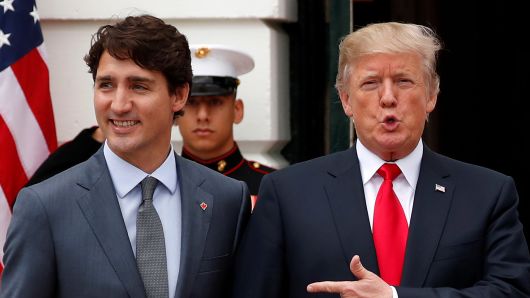CPA Chairman was quoted in this article: Foreign leaders “keep underestimating Trump on trade,” said Dan DiMicco, a former steel executive and trade adviser to Trump who was with the president Friday in Charlotte. “If he’s not tough on everybody, why is China going to believe he’s going to be tough on them?”
President Trump on Saturday threatened to withdraw the United States from the North American Free Trade Agreement, asserting his right to broker a new trade pact that does not include Canada despite opposition from lawmakers and questions over his legal authority to do so.
[Heather Long | September 1 , 2018 | Washington Post]
Trump on Friday formally informed Congress of his intent to enter into a trade deal with Mexico, with the notice adding the administration hopes Canada would be added to the new pact later. U.S. and Canadian negotiators worked throughout the week on adding Canada to Friday’s notice, but the negotiations failed to produce an agreement ahead of Trump’s own Friday deadline.
Negotiations with Canada are set to continue Wednesday in the hopes of adding Canada to the deal. Lawmakers have told Trump they will only sign onto a new NAFTA deal that includes all three North American nations.
But Trump issued a warning Saturday to both Canadian Prime Minister Justin Trudeau and Congress in a post on Twitter, writing he would go on without Canada and could unwind North American free trade if lawmakers would not support his approach.
“There is no political necessity to keep Canada in the new NAFTA deal. If we don’t make a fair deal for the U.S. after decades of abuse, Canada will be out. Congress should not interfere w/ these negotiations or I will simply terminate NAFTA entirely & we will be far better off…” Trump wrote.
“We make new deal or go back to pre-NAFTA!” Trump wrote as part of a subsequent post.
It’s unclear whether Trump could withdraw from NAFTA without support from Congress, though he has repeatedly threatened to do so. Many lawmakers have said they would move to stop Trump if he attempts to withdraw from the deal, and the move would probably face legislative and legal challenges.
The withdrawal process would require Trump to give Mexico and Canada six months’ notice of his intent to leave the pact.
Ending NAFTA without a replacement would cause large-scale economic disruption across North America and beyond. Companies accustomed to moving products across borders with few or no taxes would see costs jump — price hikes that would pass to consumers — and domestic producers would find their access to foreign markets diminished.
Canada is the No. 1 destination for American products shipped abroad, and more than 8 million U.S. jobs are supported by trade with Canada, according to the U.S. Chamber of Commerce.
The move would shelter some domestic industries from foreign competition, part of Trump’s aim to revitalize some domestic industries that have opted to move production overseas.
U.S. lawmakers have generally backed NAFTA, saying the overall economic benefits of cheaper products and greater efficiency have outweighed the negative consequences of job losses. But Trump has focused on areas where industrial decline has led to deep economic hardship.
Trump’s renewed threat to withdraw from NAFTA comes as U.S. Trade Representative Robert E. Lighthizer and Canadian Foreign Affairs Minister Chrystia Freeland are set to resume negotiations Wednesday.
The two sides are divided over substantive issues such as rules governing trade of dairy products, patent protections for pharmaceuticals and disagreements over the process for resolving trade disputes.
Canadian officials accused the U.S. side of refusing to offer concessions. That sentiment appeared validated Friday morning when the Toronto Star published comments Trump had made in which he told Bloomberg News journalists that negotiations to rework NAFTA would take place only on his terms.
Trump is attempting to get a new NAFTA deal signed before current President Enrique Peña Nieto leaves office Dec. 1. Nieto’s successor, Andrés Manuel López Obrador, has had representatives at the U.S.-Mexico talks, but if the deal is not signed before he takes office he could add new demands and complicate the deal.
That timeline was the impetus for Trump’s Friday letter to Congress notifying them of the preliminary agreement with Mexico. That letter started a 90-day required notice period for Congress before the president can legally sign a new deal.
Now, under U.S. trade law, Trump has 30 days from Friday to get final text to Congress.
If Canada is not included in that final text, it would be legally very difficult — if not impossible — to include the country later.
For Canada, losing access to the U.S. market would be a severe economic blow. And Trump has further threatened to put 25 percent tariffs on cars and auto parts sent from Canada into the United States — a move he could make without Congress’s permission.
Foreign leaders “keep underestimating Trump on trade,” said Dan DiMicco, a former steel executive and trade adviser to Trump who was with the president Friday in Charlotte. “If he’s not tough on everybody, why is China going to believe he’s going to be tough on them?”
But for Trump, failing to get Canada on board would set up a showdown with Congress in which all parties would be in murky legal territory. It’s unclear whether the authority Trump has to renegotiate NAFTA extends to a deal done with just Mexico, and lawmakers — as well as Mexican officials — continue to stress the need for Canada’s inclusion.













